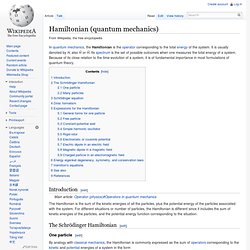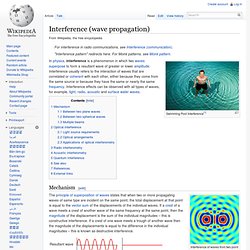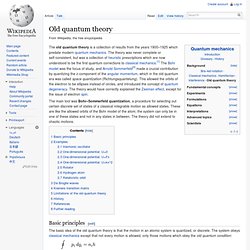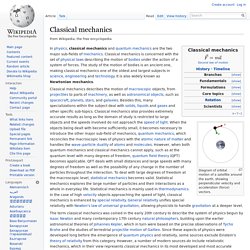

Hamiltonian (quantum mechanics) The Hamiltonian is the sum of the kinetic energies of all the particles, plus the potential energy of the particles associated with the system.

For different situations or number of particles, the Hamiltonian is different since it includes the sum of kinetic energies of the particles, and the potential energy function corresponding to the situation. By analogy with classical mechanics, the Hamiltonian is commonly expressed as the sum of operators corresponding to the kinetic and potential energies of a system in the form where is the potential energy operator and. Bra-ket notation. In quantum mechanics, bra–ket notation is a standard notation for describing quantum states, composed of angle brackets and vertical bars.

It can also be used to denote abstract vectors and linear functionals in mathematics. It is so called because the inner product (or dot product on a complex vector space) of two states is denoted by a ⟨bra|ket⟩, consisting of a left part, ⟨φ|, called the bra /brɑː/, and a right part, |ψ⟩, called the ket /kɛt/. The notation was introduced in 1939 by Paul Dirac[1] and is also known as Dirac notation, though the notation has precursors in Grassmann's use of the notation [φ|ψ] for his inner products nearly 100 years previously.[2][3] Bra–ket notation is widespread in quantum mechanics: almost every phenomenon that is explained using quantum mechanics—including a large portion of modern physics — is usually explained with the help of bra–ket notation. Vector spaces[edit] Background: Vector spaces[edit] though the coordinates are now all complex-valued. where. Interference (wave propagation)
Swimming Pool Interference[1] Interference of waves from two point sources.

Magnified-image of coloured interference-pattern in soap-film. The black "holes" are areas where the film is very thin and there is a nearly total destructive interference. Consider, for example, what happens when two identical stones are dropped into a still pool of water at different locations. Each stone generates a circular wave propagating outwards from the point where the stone was dropped. Geometrical arrangement for two plane wave interference Interference fringes in overlapping plane waves A simple form of interference pattern is obtained if two plane waves of the same frequency intersect at an angle. It can be seen that the two waves are in phase when and are half a cycle out of phase when Constructive interference occurs when the waves are in phase, and destructive interference when they are half a cycle out of phase. And df is known as the fringe spacing. A point source produces a spherical wave. For to. Old quantum theory. The main tool was Bohr–Sommerfeld quantization, a procedure for selecting out certain discrete set of states of a classical integrable motion as allowed states.

These are like the allowed orbits of the Bohr model of the atom; the system can only be in one of these states and not in any states in between. The theory did not extend to chaotic motions. Basic principles[edit] The basic idea of the old quantum theory is that the motion in an atomic system is quantized, or discrete. The system obeys classical mechanics except that not every motion is allowed, only those motions which obey the old quantum condition: Classical mechanics. Diagram of orbital motion of a satellite around the earth, showing perpendicular velocity and acceleration (force) vectors.

In physics, classical mechanics and quantum mechanics are the two major sub-fields of mechanics. Classical mechanics is concerned with the set of physical laws describing the motion of bodies under the action of a system of forces. The study of the motion of bodies is an ancient one, making classical mechanics one of the oldest and largest subjects in science, engineering and technology. It is also widely known as Newtonian mechanics. The term classical mechanics was coined in the early 20th century to describe the system of physics begun by Isaac Newton and many contemporary 17th century natural philosophers, building upon the earlier astronomical theories of Johannes Kepler, which in turn were based on the precise observations of Tycho Brahe and the studies of terrestrial projectile motion of Galileo.
History[edit]